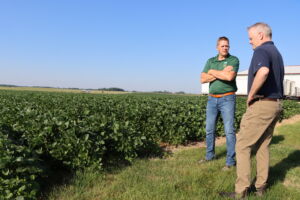MSGA: China trade deal needed as harvest nears
MSGA: China trade deal needed as harvest nears

An economic crisis is looming in farm country as harvest approaches, and the Minnesota Soybean Growers Association (MSGA) is sounding the alarm before it’s too late.
“The crop is looking solid, but we need to get our soybeans moving,” said MSGA President Darin Johnson. “With zero sales going to China right now, it’s going to put a lot of pressure on our farmers going into the fall, and it’s going to cost farmers a lot of money. Unfortunately, we’re bearing a lot of this trade war.”
MSGA and the American Soybean Association (ASA) are urging President Trump to prioritize soybeans in U.S.-China trade talks, warning that retaliatory tariffs are shutting American farmers out of their largest export market heading into the 2025 soybean harvest.
As Minnesota’s soybean farmers prepare to harvest a potential bumper crop, time is of the essence to hatch a long-term deal that brings certainty to the marketplace. In a letter sent Aug. 19 to the White House, ASA implored the president to work on removing Chinese tariffs on U.S. soybeans and secure commitments for future purchases. ASA also released an economic report underscoring the dire financial consequences of losing long-term market share in China.
“U.S. soybean farmers are standing at a trade and financial precipice,” ASA President Caleb Ragland, a soybean farmer from Kentucky, wrote in the letter. “Soybean farmers are under extreme financial stress. Prices continue to drop and at the same time our farmers are paying significantly more for inputs and equipment. U.S. soybean farmers cannot survive a prolonged trade dispute with our largest customer.”
China’s imports of U.S. soy exceed all other international markets combined. China has historically imported more than 60% of the world’s soybean supplies, with the U.S. once serving as its top source. But retaliatory tariffs now make U.S. soybeans 20% more expensive than South American supplies. Accordingly, China has turned to Brazil, which has expanded production to meet demand.
“China is an important customer of ours, and we need to find some results,” said Johnson, a fourth-generation soybean and corn farmer from Wells. “This is going to potentially open up some new trade partners, which is good, but filling in that gap is really difficult without China making those purchases.”
Minnesota’s nearly 26,000 soybean farmers depend on trade for their profitability. Soybeans are Minnesota’s top ag export, valuing over $2 billion each year. About one in four rows of Minnesota soybeans is typically destined for China; however, prior to the 2018-19 trade war, China accounted for one of every three rows of Minnesota soybeans.

MSGA President Darin Johnson (background) and Executive Director Joe Smentek, pictured here in 2024, continue advocating for a swift resolution to the U.S.’ ongoing trade dispute with China.
“Everyone agrees that something has to get done quickly,” said Bob Worth, a Lake Benton farmer and ASA director. “I’m worried about our younger farmers – this could put them in a very tough spot.”
Soy farmers have skin in the game in China. U.S. soybean farmers began cultivating the the Chinese market four decades ago, thanks to a combination of forward-thinking checkoff investments and market development advocacy. Jeopardizing once-stable trade relationships could devastate not just farmers, but rural economies and communities across Minnesota and the country. That was message was shared by MSGA Executive Director Joe Smentek during this week’s Soy Connext global trade conference in Washington, D.C., and MSGA leaders, who visited with Minnesota’s congressional delegation Aug. 18 during the Minnesota Ag Leadership Conference.
“We had some good conversations about not just trade, but the overall state of the ag economy,” Johnson said. “Our legislative leaders understand and appreciate that times are tough and they’re doing everything they can for us in D.C. to get some policies moving in the right direction.”
Unlike the 2018-2019 trade war, farmers are navigating a far more turbulent farm economy in 2025, including falling commodity prices and increased input costs. While soybean futures are hovering around $10, basis prices are widening across Minnesota farm country “because we don’t have a home for our soybeans,” Worth said.
“Something has to be done to make the balance of trade better, but we also have to figure out how we’re going to protect our farmers, so we don’t lose a generation of farmers,” Worth said. “No one wants to see farmers get caught in the middle, and if we don’t get something done in the next month or two with China, it’s going to get serious.”
Ever the optimist, Johnson remains hopeful in the growing season’s remaining weeks.
“We’re not at the finish line yet,” he said. “Time is running out, but we hope our policy leaders can come to the table and make a deal that protects agriculture.”


